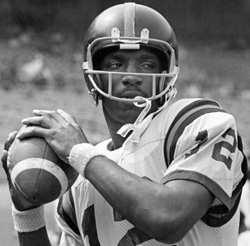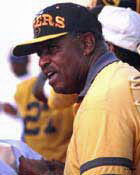|
Profile: Doug Williams
If you asked Doug Williams when he entered high school what he wanted to be, he would have replied, "Major league pitcher." As part of the first integrated baseball team at Central High School in East Baton Rouge Parish, Doug once struck out 18 batters in a six inning game.
Hoping to toughen up his little brother, Robert Williams steered Doug toward football beginning in the eighth grade. "Doug did not want to play football, but I forced him to play," recalled Robert. After a growth spurt to 6'4", Doug started for Chaneyville High School as a junior and senior.
"There were only two schools I wanted to play for out of high school, either Grambling or USC," said Williams. But USC didn't recruit Doug because they had Jimmy Jones, a black quarterback who was Doug's idol. So he accepted a scholarship to Grambling to play for legendary coach Eddie Robinson. Doug's college career culminated in his being named the first black First-Team All-American quarterback by the Associated Press.
    L-R: Doug Williams, Jimmy Jones, Eddie Robinson, John McKay The Tampa Bay Buccaneers, desperately in need of a quarterback in their third season in the NFL and convinced that Williams's powerful arm could lift them out of their NFL-record 26-game losing streak, drafted Doug in the first round of the 1978 Draft. Ironically, the Bucs head coach was John McKay, the man who made Jimmy Jones the first black quarterback at USC.
With the tutelage of the Bucs' new offensive coordinator, Joe Gibbs, Williams started 10 games his rookie season. Then he started all 16 games in 1979, '80, and '81. The '79 Bucs won the NFC Central Division and defeated the Eagles in the first round of the playoffs before losing to the Rams.
When Williams' contract with Tampa Bay expired after the 1982 season, he became a restricted free agent. The Bucs refused to offer him a good-faith contract, but that snub was overshadowed in April, 1983, when Doug's wife died from complications after surgery to remove a brain tumor eleven weeks after giving birth to their first child. "Suddenly, I didn't give a damn if I played another down of football or not," he said.
Doug returned to football in the spring of 1984 for the Oklahoma Outlaws of the United States Football League. The Outlaws merged with the Arizona Wranglers for 1985.
When the league folded after the '85 season, Doug worked as an assistant coach at Southern University in Baton Rouge, just a few miles from where his parents cared for his three-year-old daughter.
Joe Gibbs, Williams' offensive coordinator his first year in Tampa, was entering his sixth season as head coach of the Washington Redskins, a team that extensively scouted the USFL for players. One that they targeted was Williams. Washington GM Bobby Beathard said that "outside of Jim Kelly, we had him rated as the top quarterback in the USFL."
So the Redskins traded a fifth-round draft choice to acquire the rights to Williams from Tampa Bay and signed him to a three-year contract. |
Football Profiles Archives - I
John Heisman
Sammy Baugh Glenn Presnell Mac Speedie Wahoo McDaniel Stephen Neal Chris Cagle Brad Van Pelt Jake Delhomme Football Profiles Archives - II Paul Brown
Football Profiles Archives - III Earl Blaik
Football Profiles Archives - IV Ernie Nevers
Riley Skinner Brian Kelly Alex Karras Merlin Olsen Ryan Who? Joe Bellino Chris Long Football Profiles Archives - V Don Shula
Joe Don Looney Charlie Justice Jimmy Taylor Jesse Harper Football Profiles Archives - VI Dak Prescott
Bill Walsh - I, II, III, IV, V, VI, VII |